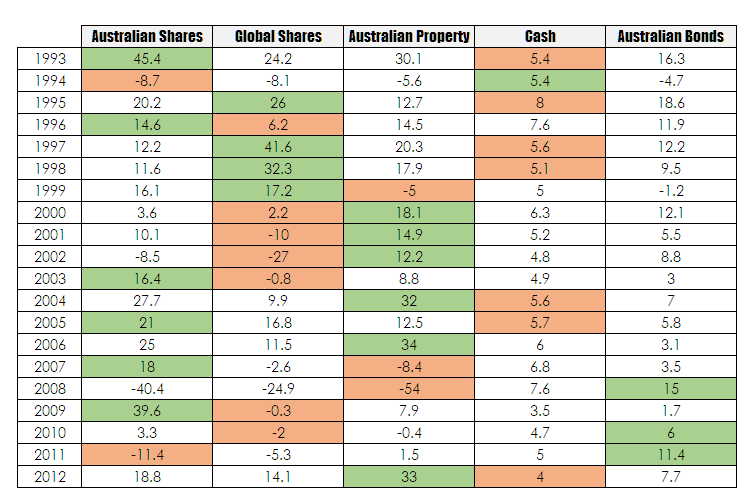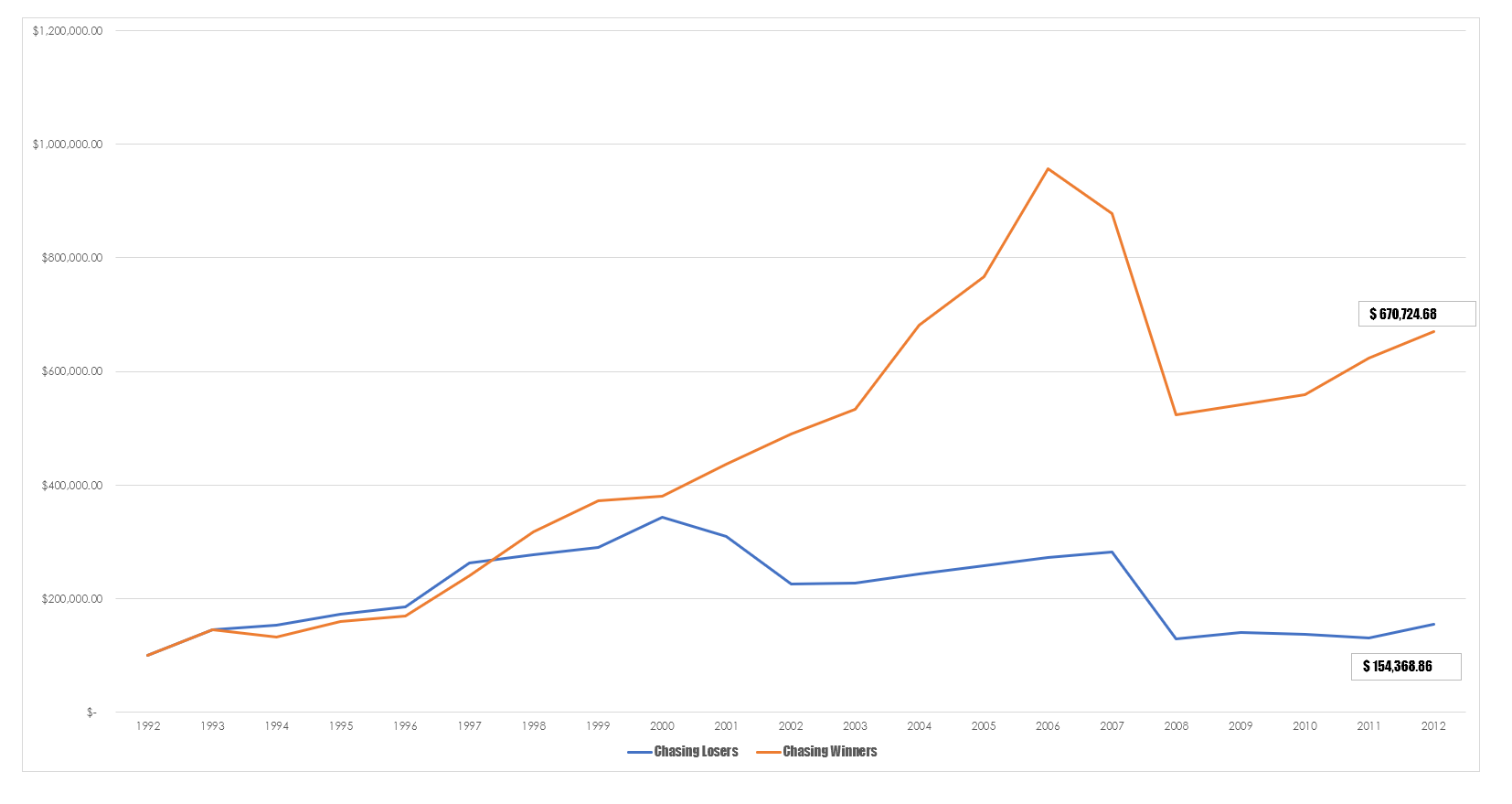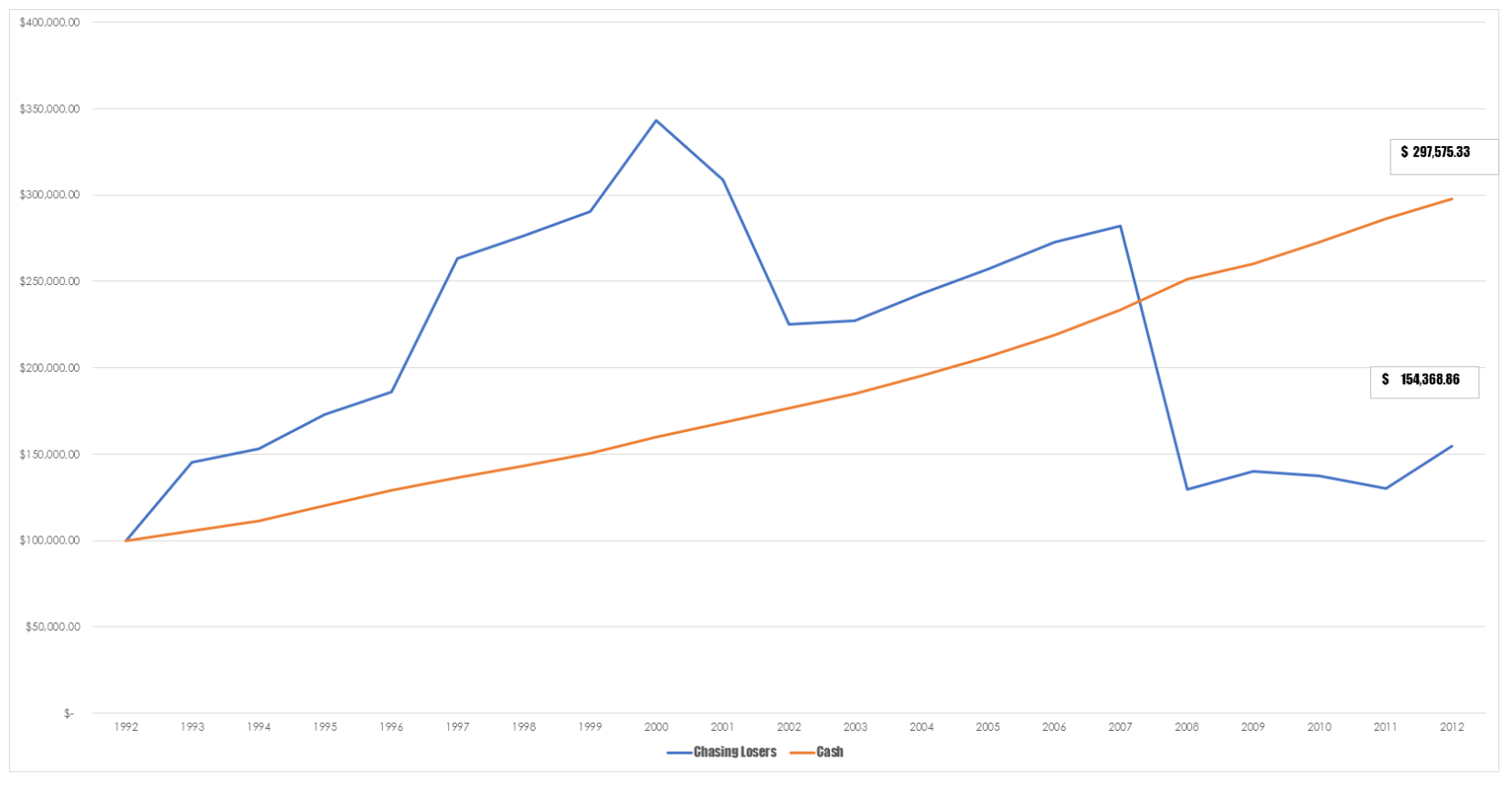One of the difficulties that new investors face is the extraordinary range of investing strategies that are presented to them. These strategies are often presented as gospel from what new traders would perceive to be sources of authority. One of the oldest chestnuts that I absolutely abhor is the notion of dollar cost averaging which is a staple of overpaid and under performing fund managers, financial planners who have done a dodgy weekend course and stockbrokers looking to jack up their monthly commission statement. I have written extensively on this topic before and you can search the blog archive to find what I have written. Suffice to say it doesn’t work. However, I was reminded of another little piece of investment wisdom that goes around regularly that I had completely forgotten about and that is the notion of chasing losers. This knee jerk contrarianism is often given the fatuous homily of buying straw hats in winter. The central tenet is that when an asset or asset class is doing well you sell it and buy one that is not doing well. The notion is that assets tend to mean revert, so if something is doing well its performance will eventually drop off whereas those doing poorly will lift back towards their long term average performance.
What piqued my interest in this idea again was a spam email I got the other day and promptly deleted but not before snipping out the performance table in the email which I believe is from Vanguard. The internet is awash with the sorts of tables so they are easy enough to find. I took the original data and dropped into Excel so it was easier to manipulate.

As you can see we have a series of investment classes and their yearly performance dating back to 1993. The worst performing asset of a given year is shaded red whereas the best is shaded green. To test the notion of buying straw hats in winter I decided to set up a hypothetical portfolio of $100,000 which rebalanced itself fully each year into the worst performing asset class of that year. I have assumed that the portfolio begins in 1993 fully invested in Australian shares and at the end of that year it is then fully invested in the worst performing asset of that year – in this case cash. So the performance for the next year is 5.4% – this process of looking for the worst performing asset is then repeated each year. To benchmark against this I generated another portfolio that looked for the best performing market of that year and then rebalanced itself fully into that market. This portfolio also begins trading fully invested in local shares. The best performing market for that year was local shares so the portfolio stays fully invested in this asset for the next year and records a performance of -8.7%. When I generated an equity curve for the two portfolios I got the following –

Chasing losers or rebalancing towards under performing assets is a stupid idea and in part explains why fund managers do so poorly since it is part of the rich cornucopia of idiocy that occupies their time. What is interesting is that this strategy even under performs a cash only investment.

This raises the question of why doesn’t this idea work since the notion of mean reversion is long established statistical principle. However, it it is this very principle that defeats this strategy. In the table below I have reordered the markets to display their long term average performance in descending order.

It is obvious that the long term performance for Australian shares is higher than the long term performance of cash. What this means is that even if shares have a stellar year and revert to their long term average this long term average is still going to be higher than the long term average of cash. This becomes even more problematic when we look at how the performance of each instrument is bounded or constrained by its simple market dynamics. Cash/bonds will always have performance that is to a greater of lesser degrees constrained by government fiat. There is a role for cash within investment portfolios but it is only as a save haven in times of volatility. In addition to this the notion fo constant switching into non performing asset classes ignores the idea of persistence within markets/instruments. Markets tend to have memory or a positive Hurst exponent – periods of out performance tend to last as do periods of under performance. However, traders need these periods of strong performance to pay for the periods when markets are range bound. And clever traders now how to deal with these periods of strong performance to maximise any utility that its to be gained from them.
This brings me to the problems with my little experiment. The first glaring problem is with the notion of having residential real estate within an active portfolio – I have assumed that the figures quoted were for residential property and I have also assumed completely unrealistically that you can switch in an out of this asset class in the same manner you would equities. As a result of this unrealistic assumption I have ignored the impact of transaction costs on the switching, whilst costs are minimal for equities/cash they are horrendous for property.
Once we begin to look at strategies from a rational perspective as opposed to the appeal of their narrative we begin to see that most have no foundation to them and trading reverts to three simple rules.
1.Buy whatever is trending up over the time frame you are trading.
2. Sell whatever is trending down over the time frame you are trading.
3. Dont bet the farm.
Intriguingly this is the anthisis of buying straw hats in winter which states that you.
1. Buy whatever is trending down over the time frame you are trading
2. Sell whatever is trending up over the time frame you are trading.
3. Bet the farm – in fact keep betting the farm long after the farm has burnt down and your wife has left you taking your favourite pig Ethel with her.





So much common sense, where has it vanished to!?